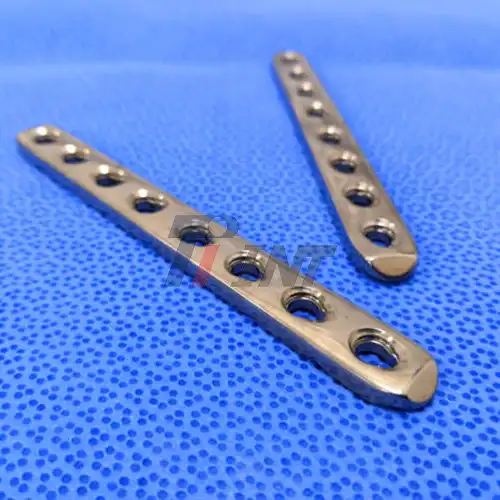The Advantages of Titanium Plates in Wrist Fracture Treatment
Titanium plate for wrist fracture have revolutionized the field of orthopedic surgery, particularly in the treatment of wrist fractures. These plates offer a myriad of benefits that make them an optimal choice for fracture fixation. Titanium's biocompatibility is paramount, as it significantly reduces the risk of allergic reactions or rejection by the body. This metal's exceptional strength-to-weight ratio allows for robust support without adding unnecessary bulk to the surgical site.
Moreover, titanium's corrosion resistance ensures the longevity of the implant, which is crucial for patients who may need the plate to remain in place for extended periods. The material's ability to osseointegrate – bond directly with bone tissue – promotes faster healing and reduces the likelihood of implant loosening over time. This property is particularly advantageous in wrist fractures, where stability is key to regaining full range of motion and strength.
Another significant advantage of titanium plates is their radiolucency. This characteristic allows for clear visibility on X-rays and other imaging studies, enabling surgeons to accurately assess the fracture's alignment and healing progress without the plate obscuring the view. This transparency to radiation also facilitates postoperative monitoring and ensures that any complications can be detected early.
The versatility of titanium plates is noteworthy. Manufacturers can produce these plates in various shapes and sizes, allowing surgeons to select the most appropriate option for each unique fracture pattern. This customization potential ensures optimal fit and function, which is crucial for the complex anatomy of the wrist.
Surgical Procedure: Implanting a Titanium Plate for Wrist Fracture
The surgical procedure to implant a titanium plate for wrist fracture stabilization is a meticulous process that requires precision and expertise. Before the surgery, the orthopedic surgeon will carefully evaluate the fracture through imaging studies to determine the most suitable plate size and configuration. This preoperative planning is crucial for ensuring the best possible outcome.
The procedure typically begins with the patient under general anesthesia. The surgeon makes an incision over the fracture site, taking care to protect surrounding nerves and blood vessels. Once the fractured bones are exposed, the surgeon meticulously realigns the fragments to their correct anatomical position. This step is critical, as proper alignment is essential for restoring the wrist's functionality and preventing long-term complications.
With the bones aligned, the surgeon selects the pre-contoured titanium plate that best fits the patient's anatomy and fracture pattern. In some cases, the plate may need to be slightly adjusted to ensure a perfect fit. The plate is then carefully positioned over the fracture site and temporarily held in place.
Using specialized surgical drills, the surgeon creates pilot holes in the bone for the screws that will secure the plate. The titanium screws are then inserted through the plate and into the bone, effectively anchoring the plate and holding the fracture fragments in their correct positions. The number and placement of screws vary depending on the fracture's complexity and the chosen plate design.
Once the plate is securely fastened, the surgeon thoroughly irrigates the surgical site to remove any debris and checks the wrist's range of motion to ensure that the plate does not impede movement. The incision is then closed using sutures or surgical staples, and a sterile dressing is applied.
Throughout the procedure, the surgeon may use intraoperative fluoroscopy – real-time X-ray imaging – to confirm proper plate placement and fracture reduction. This technology allows for immediate adjustments if necessary, increasing the likelihood of a successful outcome.
Recovery and Rehabilitation Following Titanium Plate Fixation
The recovery process after titanium plate fixation for a wrist fracture is a journey that requires patience, dedication, and a collaborative effort between the patient and healthcare providers. While the titanium plate for wrist fracture provides immediate stability to the fracture, allowing for early mobilization, the body still needs time to heal and adapt to the implant.
Immediately following surgery, patients can expect some pain and swelling, which are typically managed with prescribed pain medications and elevation of the affected limb. A splint or cast may be applied to protect the wrist during the initial healing phase, usually lasting for about two weeks. During this time, patients are advised to keep the surgical site dry and clean to prevent infection.
After the introductory recuperation period, the center shifts to restoration. Physical treatment plays a significant part in reestablishing quality, adaptability, and work to the wrist. The recovery program is regularly custom-made to each patient's particular needs and the nature of their break. It frequently starts with delicate range-of-motion workouts and continuously advances to more challenging exercises that construct quality and progress coordination.
The presence of the titanium plate allows for a more aggressive rehabilitation approach compared to non-surgical treatments. Patients can often begin light activities with their wrist earlier, which helps prevent stiffness and muscle atrophy. However, it's imperative that patients follow their surgeon's and physical therapist's guidelines to avoid overexertion and potential complications.
Full recuperation time shifts among people but ordinarily ranges from three to six months. Amid this period, patients will take note of continuous advancements in their wrist's quality and portability. It's imperative to note that whereas the titanium plate gives fabulous solidness, the bone still needs time to completely mend. Patients are more often than not prompted to dodge high-impact exercises or overwhelming lifting until cleared by their specialist.
Long-term outcomes for patients with titanium plate fixation are generally positive. Many individuals regain full or near-full function of their wrist, allowing them to return to their daily activities and even sports. The titanium plate often remains in place indefinitely unless it causes discomfort or other issues, in which case a second surgery to remove the plate may be considered.
Customary follow-up arrangements with the orthopedic specialist are basic to screen mending advance and address any concerns. These visits ordinarily incorporate X-rays to evaluate bone recuperating and guarantee the plate remains appropriately situated. Patients are empowered to communicate any tireless torment, solidness, or other indications to their healthcare supplier expeditiously.
Conclusion
The use of titanium plate for wrist fracture stabilization represents a significant advancement in orthopedic surgery. These implants offer superior strength, biocompatibility, and versatility, enabling surgeons to provide effective treatment for complex wrist fractures. While the recovery process requires dedication and patience, the majority of patients experience favorable outcomes, regaining wrist function and returning to their normal activities.
For those seeking high-quality titanium materials for medical applications, including plates for wrist fracture fixation, Baoji INT Medical Titanium Co., Ltd. offers a comprehensive range of titanium products. With over three decades of experience in titanium material research, development, and production, INT provides cutting-edge technology and superior quality assurance. To learn more about their medical titanium products or to discuss your specific needs, please contact them at export@tiint.com.










 2025-09-23 09:36:01
2025-09-23 09:36:01


_1752643437358.webp)
_1753926673602.jpg)





